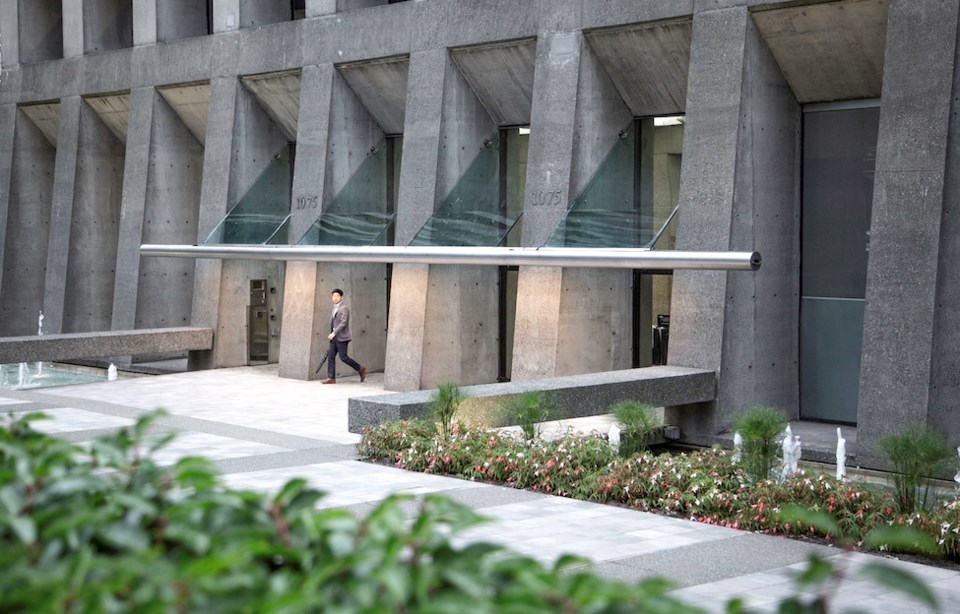With its distinctive façade and public plaza, the 26-storey tower at 1075 West Georgia Street designed by architect Arthur Erickson as the headquarters of forestry company MacMillan Bloedel soars to the sky like the West Coast forests that drove the province’s economy for decades.
But as the society recognizes the value of forests as carbon sinks, Arthur Erickson Place is echoing the trees through a low carbon footprint that recently saw it designated a Zero Carbon Building by the Canada Green Building Council, which also administers the long-standing LEED (Leadership in Energy and Environmental Design) program.
A three-year decarbonization process that began in 2022 and completes in 2025 will reduce energy use by 40 per cent and cut carbon emissions by 97 per cent, or 600 tonnes annually.
Replacing aging equipment like boilers, upgrading the hot water system with a carbon dioxide-based heat pump and use of a sophisticated decision aid system (DAS) that gathers data about energy use down to the second, using it to regulate every aspect of building operations.
“We’re able to dial things up as needed, depending on occupancy, or drop things down,” said Kit Milnes, vice-president, sustainability and resilience with KingSett Capital Inc., which purchased the tower from QuadReal Property Group in 2019 in partnership with Crestpoint Real Estate Investments Ltd. and 91原创-based Reliance Properties Ltd.
The bulk of the carbon savings will be achieved through new heat recovery chillers powered by electricity rather than natural gas, anticipating decarbonization efforts afoot in 91原创.
Building data ensured the new system was tailored to property requirements, meaning no new electrical capacity will be needed when natural gas is phased out. AEP saw peak power demand of 1500 kilowatts in June 2018 before full electrification, but the retrofit will ensure consumption is well below that level.
“We are executing this project at AEP with the existing electrical capacity that the building was originally designed and constructed with,” Milnes explained. “This building, on the electrical side, is going to be more efficient after decarbonization and fuel-switching than it was before, and that’s the big piece in how we control the operating costs and drive the financial business case to make this project viable from an investor perspective.”
Data that QuadReal had collected prior to selling 1075 West Georgia five years ago helped, with new ways to leverage property data coming online.
QuadReal is establishing a business operations centre in 91原创 that will receive data from scores of properties across Canada, aggregating it on a central platform to recognize standard parameters and improve performance. To date, more than 250,000 devices are streaming 4 million datapoints from 55 properties for analysis.
This means that new projects, such as the massive 5 million-square-foot redevelopment of Oakridge Centre in 91原创, will be more efficient as well as improving the performance of QuadReal’s existing properties.
“That allows us to do a significant amount of analytics and run [artificial intelligence] and optimization strategies, not only at a given site but also looking at trends occurring across the national portfolio,” explained Thano Lambrinos, senior vice-president, digital buildings, experiences and innovation with QuadReal.
Building systems will have an extended service life because use will be tailored to need, and QuadReal will be able to keep ahead of emerging issues that will reduce downtime.
“[We’ll] leverage all of the data coming in and start and start to look at it and identify where faults may occur in the future and get ahead of them so we can lower overall operating costs and service costs,” Lambrinos said.
The approach has been baked into the Oakridge redevelopment, which will have 70,000-plus devices streaming more than 700,000 datapoints to the central platform.
“We're deploying a number of indoor air quality sensors throughout the site that will give us a number of different readings on things like temperature and humidity, and various air particulates,” he said. “Understanding the environment that people are in, communicating that back to the HVAC control system, such that we can appropriately regulate and adjust fresh air into a space, for example … can realize all the various carbon reduction targets as well as energy goals, balancing that out with the comfort of the people.”


